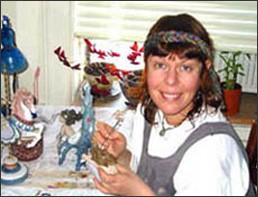Luel Restoration Studio: luelstudio.com
Greetings!
So you’re a ceramic collector or want to be one, and interested in the care and conservation of ceramic items. Or maybe you’ve inherited items that have a great sentimental value and want to know how to protect them. Before we talk about ceramic restoration and conservation, first lets define the term “ceramic”.
Conservation Register (www.conservationregister.com) offers this explanation:
Ceramic is a broad term covering all types of fired clay, including terracotta, earthenware, stoneware and porcelain. Ceramics can be roughly divided into four categories as identified below:
- Low-fired pottery or earthenware (soft, porous): Neolithic, Greek, Roman and Chinese; tin-glazed Islamic and Hispano-Moresque, Italian maiolica, French faience, Dutch delft and English delftwares; lead-glazed Islamic; slipwares, Staffordshire.
- High-fired pottery or stonewares (non-porous): Chinese Yueh ware and celadons; (salt glazed) Rhenish and English stonewares; (lead glazed) Staffordshire stonewares and cream wares; Wedgwood basalt and jasper wares (unglazed).
- Soft paste ‘imitation’ porcelain: Medici, Capodimonte, Rouen, St. Cloud, Mennency, Vincennes, Bow, Chelsea, Derby, Worcester; bone china; unglazed Parian wares.
- Hard paste ‘true’ porcelain: Chinese and Japanese porcelains, Meissen, Vienna, Sevres, Plymouth, Bristol; biscuit wares (unglazed).
Below is an excellent article from an all-about-ceramics website —
www.antiquerestorers.com
“There is a great deal of misleading information about repairing ceramics at home, and the following should be avoided.
Repairs to Avoid:
- Don’t heat up cracked plates in the oven. This can extend the crack, split the object altogether or open up old repairs.
- There are many kinds of adhesives and their use in repair of valued ceramics requires training and an understanding of chemistry. Hydrogen peroxide and sterilising preparations are sometimes recommended for cleaning ceramics – don’t use them! Their ingredients can react causing damage, including staining. If you do use adhesive at home to repair a ceramic you’ll probably find it seeps out. Commercial glues can easily yellow and can be difficult to remove. Sandpaper and scalpels should not be used.
- Painting in a damaged area should also be avoided. There are over 100 colors of white! Color matching takes great skill and training.
- Soaking old ceramics can have hidden dangers. Old repairs could become loose and porous pieces will absorb water that could cause future damage.
- If a ceramic has been repaired (even by a conservator), don’t use it for food. It could be a health hazard.
If you discover damage on a piece that is special to you (for whatever reason), contact a qualified ceramics restorer to discuss treatment. A bad home repair will cost more to rectify than getting professional advice from the start.
Read more…
If you have any questions, contact Luel Restoration Studio by e-mail: luba at luelstudio.com or call us at 646-251-5593. We offer free estimates.
All the best,
Alex K.


Dear Luba,
You did such a wonderful job restoring our Lladro figurine!
Thanks so much. You raise ceramic restoration to the level of art, where it belongs.
If you ever visit Boulder, CO, we’d love to have you over for dinner. Call us.
Thanks again.
Janet Offenbacher
Boulder, CO
USA
Dear Luba,
I was looking for a porcelain repair specialist for a few weeks until a friend recommend your website. I’m so glad we found you. Words fail me to describe the joy I felt when I received my porcelain horse, which my great-grandmother got on her wedding day. The restoration was perfect. It looks amazing. Thanks so much!!!
All the Best,
Marie de Puthod,
Los Angeles, CA